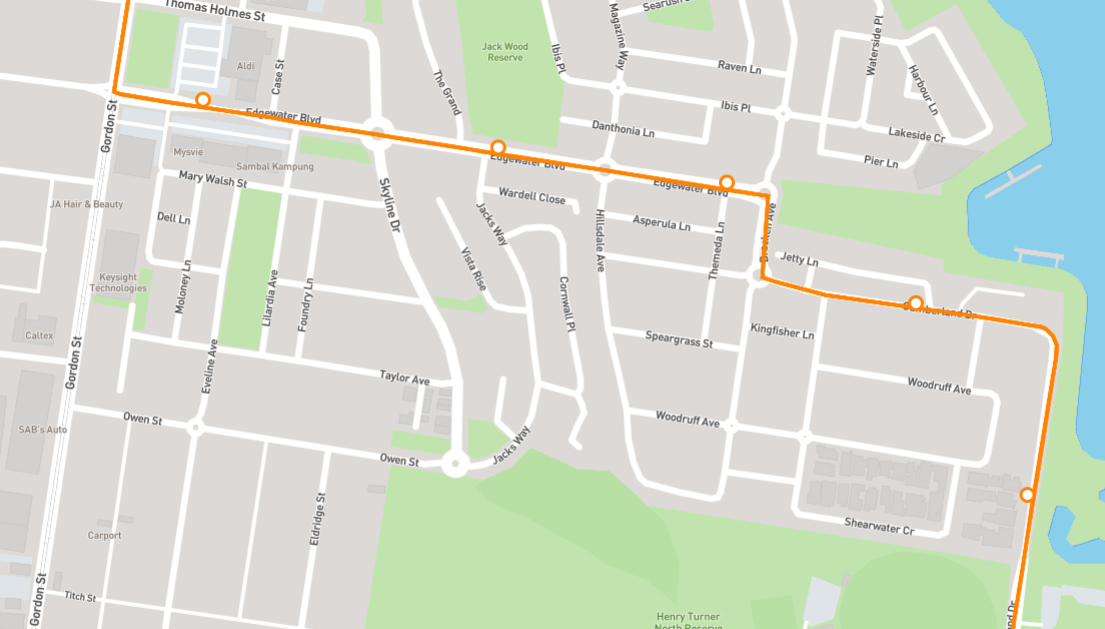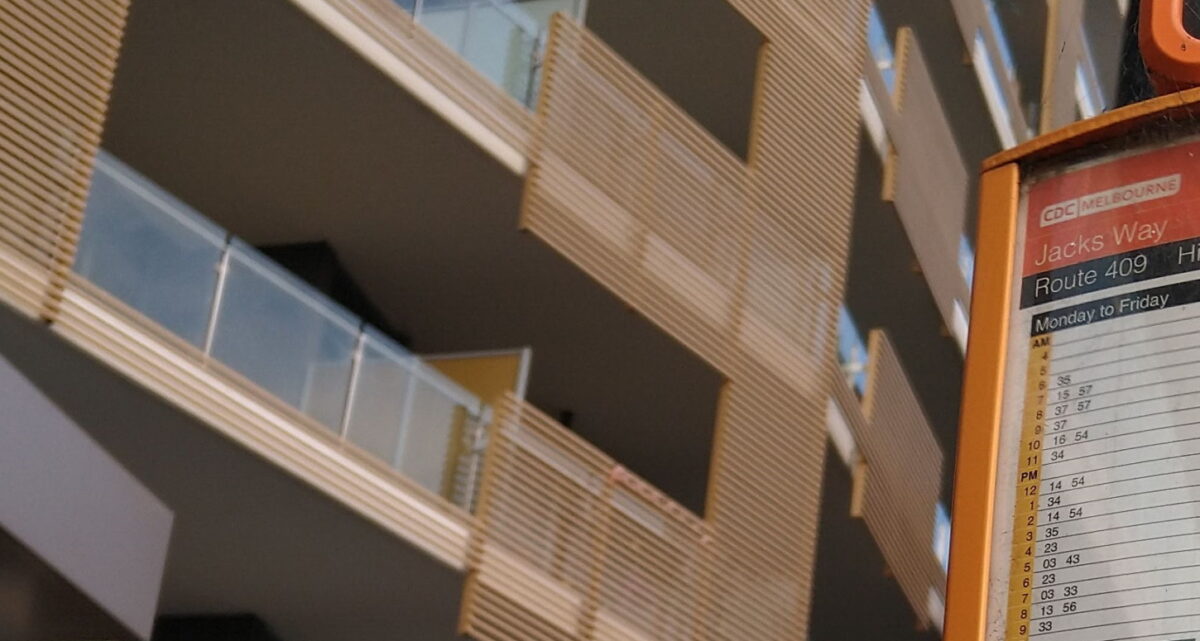You might assume that it’s only new outer suburbs where public transport services are half-baked.
But it can also be the case in new inner suburbs.

Edgewater is on the Maribyrnong River, opposite Flemington Racecourse, about 6km from the GPO. It’s former Commonwealth land which included the Footscray Ammunition Factory, and was developed over the last 15 years or so.
Now it’s mostly townhouses, but also apartment blocks of up to 8 storeys. Some of those blocks have retail in the ground floor.
I’m not sure if you’d call this medium density or high density, but there are plenty of people living here.
There is one public transport route through the estate: the 409 bus from Yarraville via Footscray to Highpoint Shopping Centre.
It’s good that the estate has a bus service. The problem is how often it runs.
- Peak hour: every 40 minutes
- Weekday daytime: every 40 minutes
- Weekend daytime: every 40 minutes
- Evenings: every 40 minutes
The last bus is just after 9pm.
Do they really expect people who have been able to afford to move into a brand new house or apartment to choose to use a bus service that runs every 40 minutes? Or will everybody just drive?
There are other routes skirting the edge of the estate.
Tram 82 and buses 472 and 406 all run nearby – these all run more frequently, about every 15-20 minutes during daytime Monday to Saturday. Only the tram offers a half-decent Sunday service, and it’s also the only one of them running after 10pm.
The presence of these more frequent service is in line with the long-running Melbourne theme: if your suburb was developed before about 1930, it probably has useable public transport. If afterwards, it probably doesn’t.
People might be prepared to walk to the more frequent services. Perhaps a third of homes are within 500 metres of route 82 and route 406 (up a steep hill), and another third within 500 metres of route 472.
But for most residents, the infrequent 409 is the closest route.
Yes, if you simply add a route serving one specific area into an existing network without changing anything else , there are complications including the likelihood of duplication.
(If done well, the duplication can provide high frequency on the shared part of the route. This didn’t happen with the 409 – its route to Footscray is different to the 82, 472 and the 406, and they depart from different stops at Footscray.)
On the bright side, at least the government did introduce route 409 when the estate was relatively young and people were still moving in.
But… a bus every 40 minutes through a medium density inner suburb. Is this good enough? And why is it that just about every public transport service in every new suburb is so underwhelming?
When will we see new estates provided with public transport that people actually want to use?




18 replies on “New suburbs, poor service”
I often hear this 40 minute headway figure in discussions of poor service levels in Melbourne over the years. It’s such a strange interval, apart from the issue of it being too infrequent for a suburban commuter service in any mode. It’s not even a memory headway, that would be 30 minutes or an hour – but 40? It’s almost like some scientific formula figure worked out years ago and followed religiously ever since.
Edgewater Estate reminds me of the video “Drive around Hulme, Manchester where the Crescents used to be – April 2012”, https://youtu.be/nU-NSkwVTL4
@Tony If a 20min headway is easy to remember, I hope, then that of a 40 minute interval is just 1/2 those trips removed (say, :00 :20 :40 or :10 :30 :50) 🙂
@Michael That doesn’t make memorization easy, since you still have to remember which hours are :00 :40 and which are :20
@Benjamin not to take this too off topic, but the :00 and :40 are assigned to even hours, :20 to odd (or vice versa). I think I get what you mean, though, if the 40 minute headway isn’t exactly 40 minutes and the minutes used don’t end in a 0 or 5 🙂
@Tony P – the 40 min headway is largely a consequence of the 20 min train headway common in the north & west – buses meet every 2nd train (not that it really matters at Footscray)
The closest alternative of every 30 mins would lead to 15 or 16 min connections for every second bus
Interstate trains are generally 15 or 30 mins outside the peaks making 40 mins very much a Victorian concept
V/Line is gradually moving towards a 40 min frequency too, which is not as justified but 30 mins could be seen as excessive to places like Ballarat (3 vs 4 trains per 2 hour window)
While it’s fair to argue a 40 min bus service is only going to cater for those without a choice, the average random wait time of 20 mins still makes it worth implementing over hourly timetables with average random waits of 30 mins
Other inner suburbs with limited service:
* Kensington Banks- no Sunday service on 404
* Parkville Gardens-505 every 60 min https://melbourneontransit.blogspot.com/2021/03/timetable-tuesday-108-parkville-gardens.html
* Alphington- limited trips/no Sat-Sun on 350 546 609
* South Yarra- 605 only every 85 min (Sun)
* Brunswick- 506 no Sunday service
There’s an easy way to remember if it’s an odd frequency. Just remember……
It’s too long of a wait, hop in the car instead.
And now a COVID exposure site!
The one-way trip on the 409 between Highpoint and Yarraville takes just over 30 minutes, so that’s probably where the 40-minute frequency comes from (two buses, assuming there’s no route change at either terminus).
One option would be to re-route the 223 through Edgewater to Highpoint rather than its current route on Rosamond Rd, without much loss of coverage (or muck around with the 215, 406 and/or 408 to give different coverage in that area rather than both the 215 and 408 going down Hampstead Rd). That would give much better overall frequency through Edgewater between Highpoint and Footscray. The 223 probably needs some work on the Yarraville side too.
People in the elevated bit of Edgewater aren’t that far from the tram (300-400m) but certainly anyone down on the floodplain might give the tram a miss.
@Steve i think better option route 223 is better merged with 406 going via Vic Uni and Gordon St
409 could be upgraded to 20 mins and rerouted via Hampstead Rd on way to Highpoint replace part of 406
I sense that there’s a lot of negativism behind this, an attitude of not many people use it, so we don’t have to provide much of a service. In this regard, Melbourne is pretty out of step with almost any other city where the position nowadays is to provide the service (make it actually attractive) and the passengers will come. Melbourne seems to be stuck in the fatalistic mindset that everybody drives so why bother. Maybe everybody drives because the public transport frequency is so poor?
I’ve done a little map and streetview touring around this estate and, yes, it’s quite high-medium density on average. There are a lot of people in a small area. Balanced against this is the fact that the tram and other bus routes are not more than about 800 metres away at an extreme, so the ones living closer will no doubt walk to the tram which takes them to a railway. Otherwise, looking at some other examples of such internal feeder buses around the traps, this is one that would justify a 15 to 30 minute frequency, peak-off peak. 40 minutes is just beyond the pale and also a very unfriendly example of what I’d call an amnesia timetable, the opposite of a memory timetable! Transit enthusiasts might be able to do clever little mathematical calculations to work out when the buses come in each hour, but I can assure you that the general public won’t and would be absolutely deterred by it. That whole 40 minute thing needs to go out the window, it’s a complete anachronism.
In a city the size of Melbourne, the absolute maximum headway of any public transport service should be 30 minutes, with a large bulk of services having a 15 minute headway at worst.
Don’t most people have and use smartphones now? All this discussion of frequency/headway/memorisation seems very esoteric. I would consult an app such as Google Maps for the best route at the particular time.
You’d be surprised how many people don’t. However, even if somebody is using an app, taking a look and seeing that it’s 30 to 40 minutes wait is a deterrent to using the service.
The Planning Scheme exacerbates this, simply because it mandates minimum provisions for cars, but has absolutely no requirement for the provision of public transport.
I agree that a 40 minute frequency bus service for a medium density inner city suburb in Melbourne is definitely not acceptable or frequent enough to attract people from their cars. Whilst yes in Edgewater’s case there is the 82 tram and a few other nearby bus routes which mean depending where you live in Edgewater you do have other public transport options, if you live within the main part of Edgewater, you are reliant on the 409 bus. I would say bus services in such areas of Melbourne and in general across the Melbourne metropolitan area should have a maximum wait time of 15 to 20 minutes in the day and 20 to 30 minutes in the evening, similar to trains and trams if they are to increase their patronage and be seen as a viable alternative to cars.
The naming of suburbs is an interesting thing. I have a relative who is currently building in Clyde North. In the Edgewater Estate there. (We went for a drive out there a while back, to see where it was, and noticed a total dearth of shops of any sort anywhere nearby. You’d think they’d include at least a milk bar if not a supermarket in walking distance of the new houses!)
[…] enough – but the real problem here is that Melbourne’s mostly woeful buses are being starved of funding for large-scale improvements, while billions and billions get thrown […]
[…] the public transport infrastructure – while lacking in accessibility – is a lot better than Edgewater, a few kilometres south. And the number of routes is […]